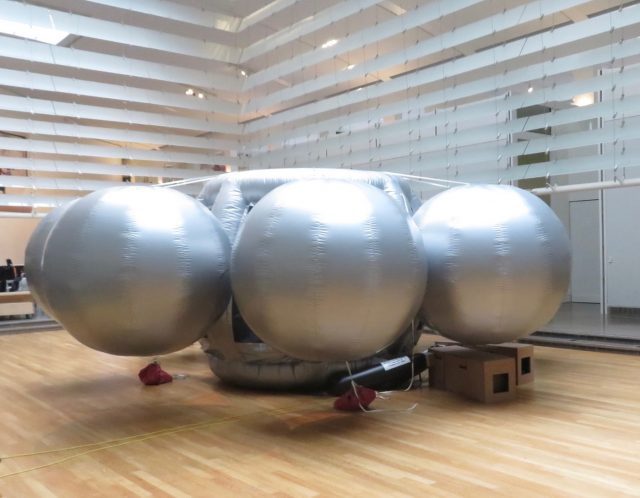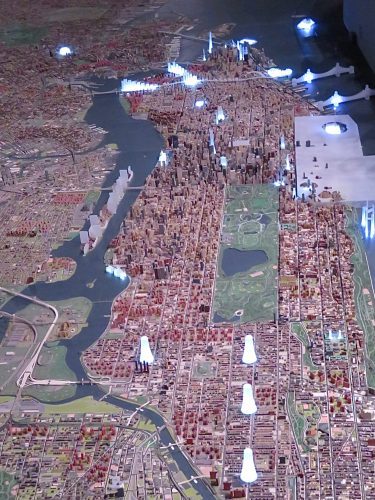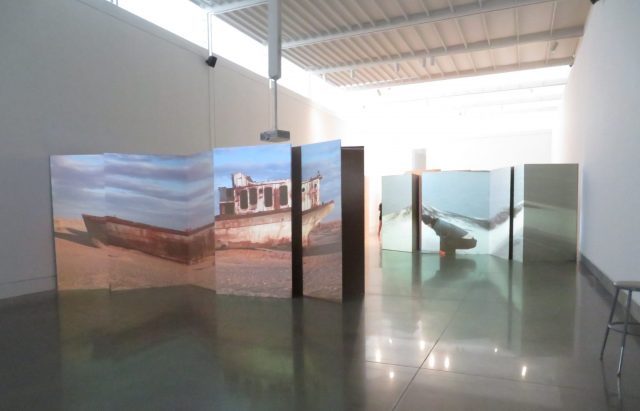
A model of Eliot Noyes’s never-built Westinghouse Pavilion for the 1964 World’s Fair is turned into a bouncy castle for kids as part of Queens Museum exhibit (photo by twi-ny/mdr)
Queens Museum
New York City Building, Flushing Meadows Corona Park
Through February 18, $8 adults, $4 seniors, free for children eighteen and under
718-592-9700
www.queensmuseum.org
Oh, what might have been. There are only a few more days left to get a gander at a Gotham that just was not meant to be in the sensational exhibit “Never Built New York,” which on February 18 will go the way of all the projects that comprise it. Curators Sam Lubell and Greg Goldin have brought together paraphernalia from nearly eighty structures, including newspaper clippings, computer renderings, models, architectural drawings, sketches, blueprints, watercolors, photographs, and more, that, for one reason or another — money, safety, graft, time, politics, war — never took form. The would-be projects range from John Rink’s 1858 Plan of the Central Park, Richard Morris Hunt’s 1866 New-York Historical Society, Alfred Ely Beach’s 1870 Beach Pneumatic Railway, and Rufus Gilbert’s 1871 Elevated Railway to several possibilities to replace the World Trade Center, Zaha Hadid’s 2012 425 Park Ave., and Work AC’s 2015 Guggenheim Collection Center. Among the familiar names who attempted and failed to reshape parts of the city are Frank Lloyd Wright, Louis Kahn, Daniel Libeskind, Robert Moses, R. Buckminster Fuller, Isamu Noguchi, Frank Gehry, I. M. Pei, Marcel Breuer, Michael Graves, Santiago Calatrava, and McKim, Mead & White.

The Panorama of the City of New York at the Queens Museum temporarily includes a series of projects that were never built (photo by twi-ny/mdr)
Moses wanted to construct the elevated Lower Manhattan Expressway from the Holland Tunnel to the Manhattan and Williamsburg Bridges. Fuller wanted to put up a pair of enormous domes, including one for a stadium for the Brooklyn Dodgers. Norman Sper was going to fill in the Hudson River to connect Manhattan with New Jersey. Venturi, Scott Brown & Associates included the world’s largest clock in their design for the Whitehall Ferry Terminal. Norman Bel Geddes’s “Rotary Airport” floated eight hundred feet off the Battery. In 1925, Harvey Wiley Corbett’s “How You May Live and Travel in the City of 1950” featured half-mile-high skyscrapers and four levels of streets for automobile traffic. There are also proposals for the Museum of Modern Art, the Guggenheim, Times Square, the Metropolitan Opera, Rockefeller Center, Grand Central Terminal, Lincoln Center, Battery Park, Columbus Circle, the Brooklyn Museum, the New York Botanical Garden, and an Olympic Village. The show is capped off by the genius idea of temporarily adding many of the projects to the museum’s glorious Panorama of the City of New York, a 1:1200 model of every street and building in the five boroughs that is kept up-to-date; be sure to use the virtual reality headsets to learn more about some of the projects and see what they might have really looked like in relation to the actually built city around them.

“Patty Chang: The Wandering Lake” includes two related videos dealing with ritual mourning and cleansing (photo by twi-ny/mdr)
Also at the Queens Museum is “Patty Chang: The Wandering Lake,” a multimedia exhibit by the California artist that features a unique exploration of water and relieving oneself in China as well as a pair of videos involving ritualistic mourning and cleansing, one of a grounded ship, the other of a beached whale; “Sable Elyse Smith: Ordinary Violence,” a complex journey into incarceration and trauma; “Julia Weist with Nestor Siré: 17.(SEPT) [By WeistSiréPC]™,” dealing with internet connectivity and file sharing in Cuba; and “Anna K.E.: Profound Approach and Easy Outcome,” in which the Georgian-born artist, who lives and works in New York City and Germany, has created a site-specific wall commission for which, in two of the pieces, she reenacts paintings by Otto Dix and Balthus at the Met, dominated by her feminine gaze.